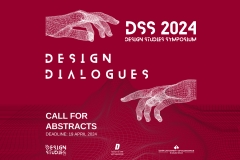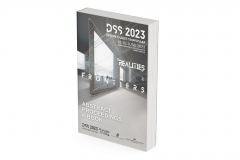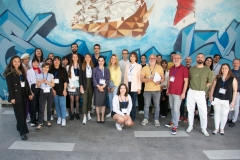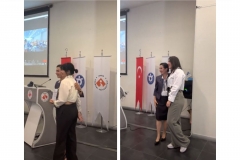
GRADUATE SCHOOL
Design Studies (With Thesis)
FFD 514 | Course Introduction and Application Information
| Course Name |
Design and Domestic Culture
|
|
Code
|
Semester
|
Theory
(hour/week) |
Application/Lab
(hour/week) |
Local Credits
|
ECTS
|
|
FFD 514
|
Fall/Spring
|
3
|
0
|
3
|
7.5
|
| Prerequisites |
None
|
|||||
| Course Language |
English
|
|||||
| Course Type |
Elective
|
|||||
| Course Level |
Second Cycle
|
|||||
| Mode of Delivery | - | |||||
| Teaching Methods and Techniques of the Course | DiscussionLecture / Presentation | |||||
| Course Coordinator | ||||||
| Course Lecturer(s) | - | |||||
| Assistant(s) | - | |||||
| Course Objectives | In connection with design theory, this course aims to examine domestic objects and products, interiors in different periods, both locally and globally. In this sense, the course aims to examine the concepts, practices and phenomena related to home culture. |
| Learning Outcomes |
The students who succeeded in this course;
|
| Course Description | This interdisciplinary course comprises of readings and discussions on critical theories of domesticity and design, regarding different decades and geographies. |
|
|
Core Courses | |
| Major Area Courses | ||
| Supportive Courses | ||
| Media and Management Skills Courses | ||
| Transferable Skill Courses |
WEEKLY SUBJECTS AND RELATED PREPARATION STUDIES
| Week | Subjects | Related Preparation |
| 1 | Introduction to the Course | |
| 2 | Domesticity in the Local Context | Ayata, S. (2002) New Middle Class and the Joys of Suburbia. In Deniz Kandiyoti and Ayşe Saktanber (ed.), Fragments of Culture. London: IB Tauris |
| 3 | Domesticity in the Local Context | National Holiday |
| 4 | Domesticity in the Local Context | Üstüner, T. and Holt, D. B. (2009), “Toward a Theory of Status Consumption in Less Industrialized Countries.” Journal of Consumer Research 37 (1): 37-56. doi:10.1086/649759 |
| 5 | Domesticity in the Local Context | Nasır, E. B., Timur, Ş. and Gürel, M. O. (2019), ‘Living rooms occupied: Narratives on the recontextualization of the “Museum-Salon” practice in modern Turkish domesticity’, Home Cultures: Journal of Architecture, Design and Domestic Space, 16:1, pp. 63–92. |
| 6 | Domesticity in the Local Context | Çağlar, A. Ş. (2002) A Table in Two Hands. In Deniz Kandiyoti and Ayşe Saktanber (ed.), Fragments of Culture. London: IB Tauris |
| 7 | Workshop | Preparing research proposals |
| 8 | Domesticity in the Western Context | Attfield, Judy. 2007. ‘Coffee Table As A Practice of Modernity’ in Bringing Modernity Home: Writings on Popular Design and Material Culture. Manchester: Manchester University Press. ISBN-13: 978-0719063268 |
| 9 | Domesticity in the Western Context | Putnam, T. (1999). “Postmodern” Home Life. In Irene Cieraad (ed.) At Home: An Anthropology of Domestic Space. [pp. 144- 154]. New York: Syracuse University Press. ISBN: 0-8156-2903-6 |
| 10 | Domesticity in the Non-Western Context | Daniels, I. M. The ‘Untidy’ Japanese House. in ed. Daniel Miller (ed.) 2001. Home Possessions. pp. 201-230 ISBN: 0-85973- 585-1 |
| 11 | Domesticity and Etnography | Pink, S., Mackley K., Moroşanu, R., Mitchell, V. and Bhamra, T. (2017). Making Homes: Etnography and Design. London: Bloomsburry Academic |
| 12 | Intertwining of Domesticity and Design | Paavilainen, Heidi, Petra Ahde-Deal, and Ilpo Koskinen. 2017. “Dwelling with Design.” The Design Journal: An International Journal for All Aspects of Design 20 (1): 13–27. |
| 13 | Intertwining of Domesticity and Design | Shove, E., Watson, M., Hand, M. and Ingram, J. (2007), The Design of Everyday Life, London: Bloomsbury |
| 14 | Course Review | |
| 15 | Final Presentations | |
| 16 | Review of the Semester |
| Course Notes/Textbooks | There is not only one course textbook in this course. |
| Suggested Readings/Materials | Fallan, Kjetil. 2010. Design History: Understanding Theory and Method. Oxford: Berg Publishers. ISBN-13 : 978-1847885371 Giddens, Anthony. 1991. Modernity and Self-Identity: Self and Society in the Late Modern Age. Stanford, CA, USA: Stanford University Press. ISBN-13 : 978-0804719445 Goffman, Erving. 1959. The presentation of self in everyday life. Garden City, NY: Doubleday Anchor Books. ISBN 13: 9780385094023 Simmel, Georg. 1903. “The metropolis and mental life.” In Kurt H. Wolff (ed.), The Sociology of Georg Simmel, [p. 409–424]. New York: The Free Press. ISBN-13 : 978-0029289204 Sparke, Penny, Anne Massey, Trevor Keeble, and Brenda Martin. (eds.). 2009. Designing the Modern Interior: From the Victorians to Today. London: Bloomsberry. ISBN: 9781847882875 Birdwell-Pheasant, Donna, and Denise Lawrence-Zuniga. 1999. House Life: Space, Place and Family in Europe. Oxford: Berg. ISBN 9781859732359 Cromley, Elizabeth Collins. 1990. Alone together: A history of New York early apartments. Ithaca, NY: Cornell University Press. ISBN 13: 9780801423246 |
EVALUATION SYSTEM
| Semester Activities | Number | Weigthing |
| Participation |
1
|
5
|
| Laboratory / Application | ||
| Field Work | ||
| Quizzes / Studio Critiques | ||
| Portfolio | ||
| Homework / Assignments |
1
|
15
|
| Presentation / Jury |
1
|
60
|
| Project | ||
| Seminar / Workshop |
1
|
20
|
| Oral Exams | ||
| Midterm | ||
| Final Exam | ||
| Total |
| Weighting of Semester Activities on the Final Grade |
4
|
100
|
| Weighting of End-of-Semester Activities on the Final Grade | ||
| Total |
ECTS / WORKLOAD TABLE
| Semester Activities | Number | Duration (Hours) | Workload |
|---|---|---|---|
| Theoretical Course Hours (Including exam week: 16 x total hours) |
16
|
3
|
48
|
| Laboratory / Application Hours (Including exam week: '.16.' x total hours) |
16
|
0
|
|
| Study Hours Out of Class |
14
|
8
|
112
|
| Field Work |
0
|
||
| Quizzes / Studio Critiques |
0
|
||
| Portfolio |
0
|
||
| Homework / Assignments |
1
|
30
|
30
|
| Presentation / Jury |
1
|
5
|
5
|
| Project |
0
|
||
| Seminar / Workshop |
1
|
30
|
30
|
| Oral Exam |
0
|
||
| Midterms |
0
|
||
| Final Exam |
0
|
||
| Total |
225
|
COURSE LEARNING OUTCOMES AND PROGRAM QUALIFICATIONS RELATIONSHIP
|
#
|
Program Competencies/Outcomes |
* Contribution Level
|
||||
|
1
|
2
|
3
|
4
|
5
|
||
| 1 | to be able to expand the practical knowledge gained in undergraduate programs with theoretical field of design research, |
|||||
| 2 | to be able to examine, interpret data and assess concepts and ideas with research methods of design theory and social sciences, |
X | ||||
| 3 | to be able to identify problems of design disciplines in times of global / environmental crisis and to be able to develop possible solutions for design practitioners, |
|||||
| 4 | to be able to expand knowledge on the history of material culture as it relates to design practices of the past, |
X | ||||
| 5 | to be able to promote research on local practices of everyday life and assess the outcome to implement design solutions, |
X | ||||
| 6 | to be able to facilitate interactions in between varied design disciplines and to promote collaborative work to solve complex problems, |
X | ||||
| 7 | to be able to process outcome of design research to be applied in design education, |
|||||
| 8 | to be able to instigate research on the new tools, technologies and materials of production in order to accelerate changes in design practices, |
|||||
| 9 | to be able to develop an ethical approach towards design professions in order to install social and environmental responsibilities, |
|||||
| 10 | to be able to use a foreign language for both chasing the scientific publication and developing proper communication with colleagues from other countries, in written and verbal ways. |
X | ||||
| 11 | to be able to use computer programs needed in the field design as well as information and communication technologies in advanced levels (“European Computer Driving Licence”, Advanced Level”). |
|||||
*1 Lowest, 2 Low, 3 Average, 4 High, 5 Highest
NEWS |ALL NEWS

DSS 2024 CALL FOR PAPERS | THEME: DESIGN DIALOGUES
DSS 2024 CALL FOR PAPERS THEME: DESIGN DIALOGUES The Design Studies Graduate Program and the Faculty of Fine Arts and Design at the Izmir

Abstract Proceedings e-Book for the Design Studies Symposium 2023 is available now!
The Design Studies Symposium 2023 (DSS 2023), organized in collaboration with İzmir University of Economics Graduate School Design Studies Master's and PhD

Design Studies Symposium 2023: Realities & Frontiers
The Design Studies Symposium 2023 (DSS 2023) organized by the IEU Graduate School Design Studies programs was held on 1-2 June, at

The Best Paper Award at the Design Studies Symposium 2023: Realities & Frontiers
The voting for the best presentation award at the Design Studies Symposium 2023 (DSS 2023) organized by the IEU Graduate School Design




